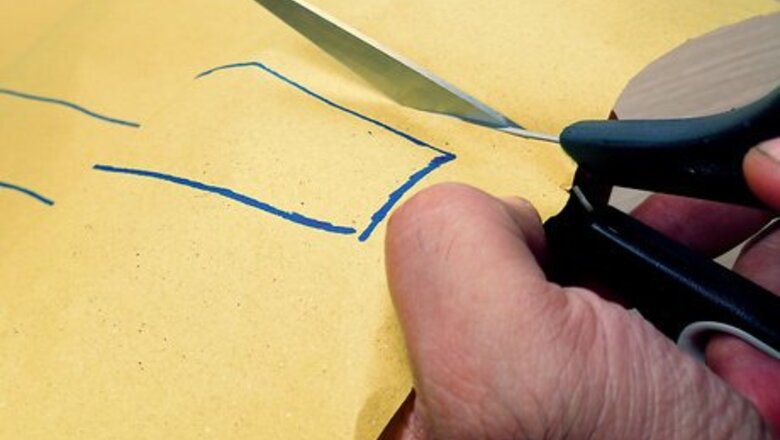
views
Making a Fake Fur Tail
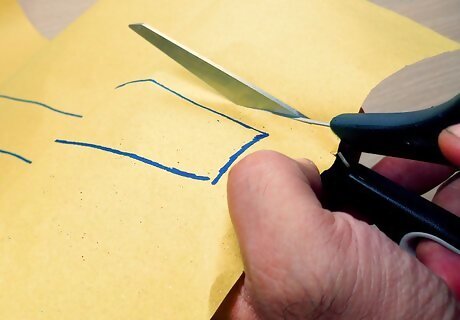
Create your pattern. Decide what shape you want your tail to be, then draw it onto a large sheet of paper or you can draw it on a drawing app such as ibis paint or other. For a cat tail, you could make a long, skinny rectangle that is rounded at one end. For a fox tail, you could make an elongated almond shape instead. It would be a good idea to add a ½-inch (1.27-centimeter) seam allowance to your pattern at this point. If you don't you'll need to add one later.
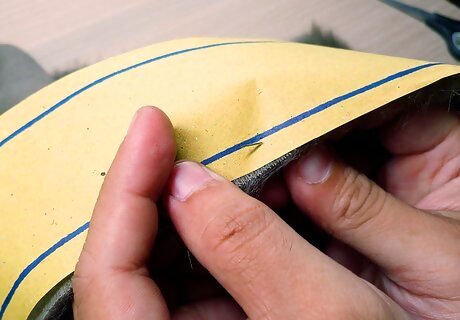
Transfer your pattern to the back of a piece of fake fur. You can pin the pattern to the fur or you can trace it using a dressmaker's chalk or pen. Make sure that the tail goes with the grain of the fabric, and that the fur ends at the tip, like a real tail. Choose long, fluffy fur for large tails, such as fox or wolf tails. Choose short fur for skinny tails, such as cat tails.
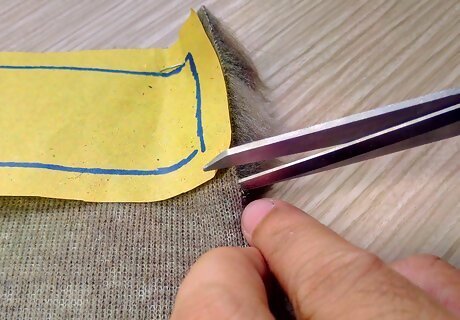
Cut the pattern out from the back of the fabric. Set the fake fur down onto a flat surface with the back side facing you. Slide the tip of your scissors into the fur, then begin to cut along the pattern. Cutting like this will prevent you from accidentally cutting the fur fibers themselves. If you did not already add a seam allowance to your pattern, be sure that you add a ½ inch (1.27-centimeter) seam allowance now. Alternatively, you can cut the pattern out using a box cutter.
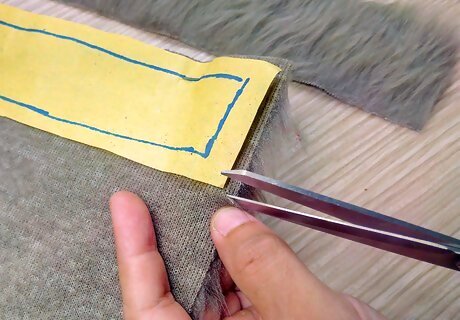
Cut another piece for the other side of the tail. If you chose a unique shape for your tail, such as a curved husky tail, make sure that you flip the pattern over first.
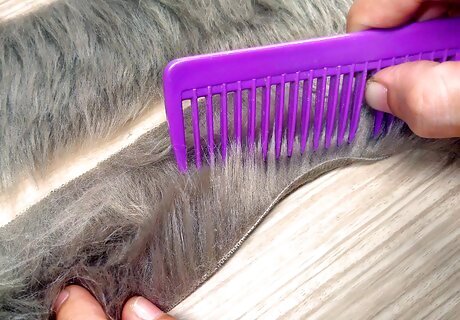
Comb the fur inwards, away from the cut edges. This includes the fur at the tip of the tail. Doing this will prevent the fur from getting caught in the seams, and make cleaning it up at the end easier.
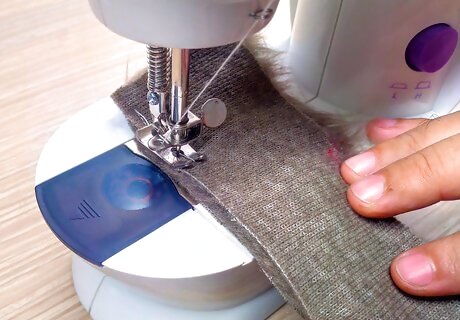
Pin and sew the tail together. Place the two pieces of fur together, with the wrong sides facing out. Sew along the fur using a ½-inch (1.27-centimeter) seam allowance. If the thread breaks, use a looser tension or switch to a stretch stitch. Leave the top of the tail open.
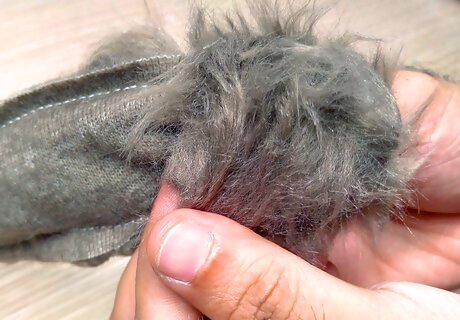
Turn the tail right-side-out through the opening at the top. Use a dowel, pen, or knitting needle to help push the end of the tail out further. If your tail had a curved shape, like a husky tail, be sure to cut notches into the curved parts. This will help it lay smoother.
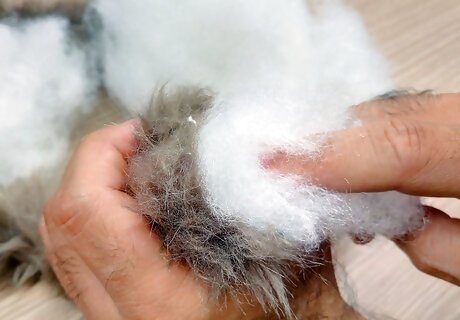
Stuff the tail with polyester stuffing or fiberfill. You can find bags of this stuff in fabric stores and arts and crafts stores. If you want a bendable tail, consider sticking a thick wire into the tail after you stuff it.
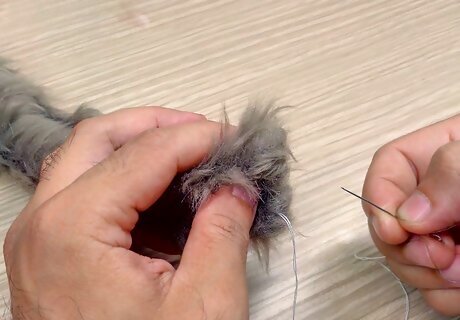
Hand sew the top of the tail shut. Tuck the raw edges into the tail, then sew the sew shut using a ladder stitch. You will be using a safety pin to secure the tail to your costume. If you'd prefer to use loops instead, cut one or two loops out of cording, and add them to the top of the tail before you sew it shut.
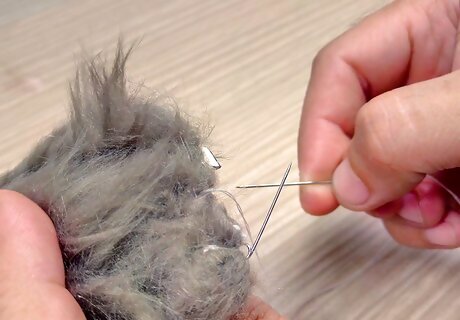
Sew a flat-backed safety pin to the top of the tail. Alternatively, you can sew a keychain ring or hook to the top of the tail instead. If you added loops of cording instead, you can skip this step and slide the tail onto a belt instead.
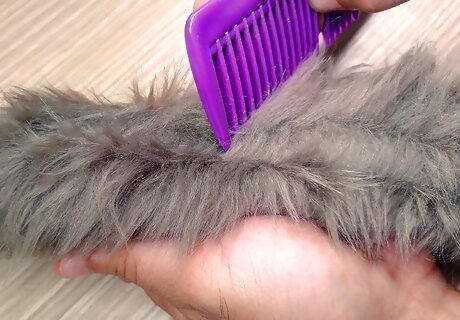
Comb or brush the fur out. Focus on the seams where the fur may have gotten caught in the stitch. Next, brush the fur from the top of the tail towards the bottom so that it lays naturally. If you make a husky tail, you will need to comb it at a downward angle instead so that it points towards the outer part of the curve. If the fur is still caught in the seams, use the tip of a knitting needle to pull it out, then comb it again.
Making a Brushed Yarn Tail

Get 100% acrylic yarn. You can use any color you want, even a "fantasy" color, such as pink, purple, or teal. The yarn must be 100% acrylic, otherwise the method will not work.
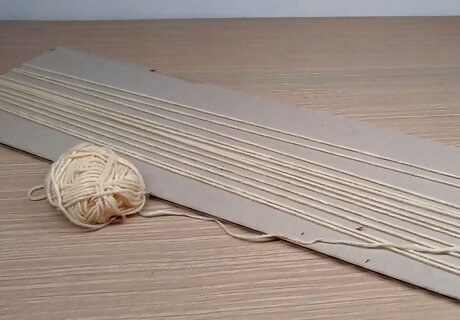
Wrap the yarn around a piece of cardboard a few times. You will be braiding this yarn, so the cardboard should be about twice the length you want your tail to be. Wrapping the yarn around the cardboard about 12 times should be enough.
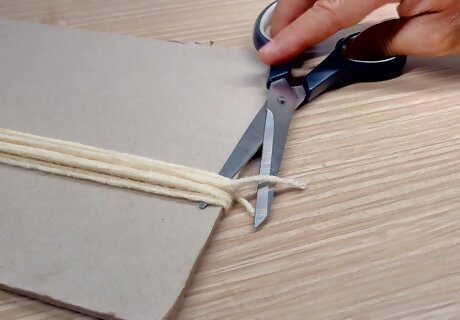
Cut one side of the loops and tie the other. Use a pair of scissors to cut the wrapped yarn along the bottom edge of the cardboard first. Slide the bundle off of the cardboard, then tie a short piece of yarn around the middle of the bundle.
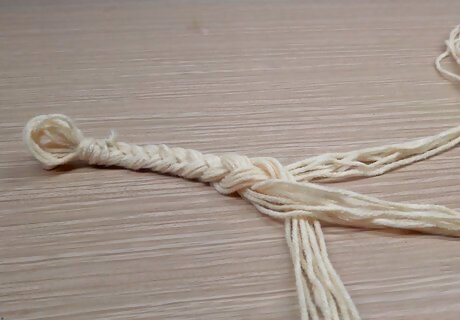
Braid the yarn together. Use the short piece of yarn to tie the bundle to a support, such as your toe, a table, or a chair. Split the yarn bundle into three even sections, then braid those sections together. Tie the tail end of the braid with another piece of yarn a few inches/centimeters from the bottom.
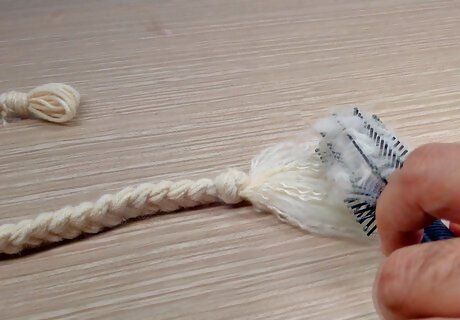
Comb out the tail end of the braid. Use a pet comb with wide bristles to brush out the yarn at the end of the braid. Keep brushing until the yarn strands unravel and turn fluffy and wavy. The tail end will become shorter and you will get a lot of fluffy bits of yarn. Discard these fluffy bits or save them for another project. The fluffy bits that come out of the yarn are perfect for making plush animals.
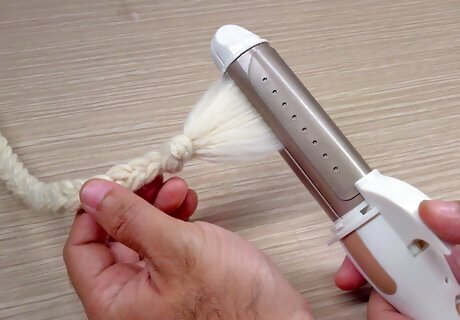
Use a hair straightener to straighten the tail end. Set a hair straightener to the lowest temperature setting possible. Working a few strands at a time, straighten the brushed yarn at the end of the braid. Keep straightening, one small section at a time, until the yarn is straight. Do not use too high of a setting, otherwise you will melt the yarn. Comb through the straightened section with a fine-toothed pet comb to help smooth them out further.
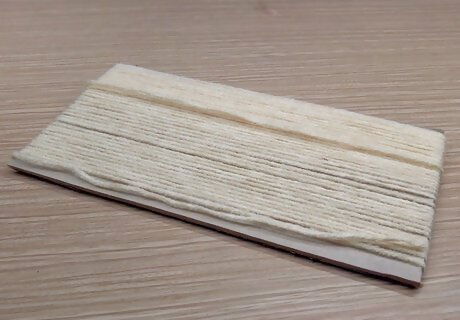
Wrap some yarn around a 7 to 8-inch (17.78 to 20.32-centimeter) piece of cardboard. Do this until the cardboard is full, then cut the yarn at the top and bottom of the cardboard. You'll end up with lots of 7 to 8-inch (cc-centimeter) pieces of yarn.
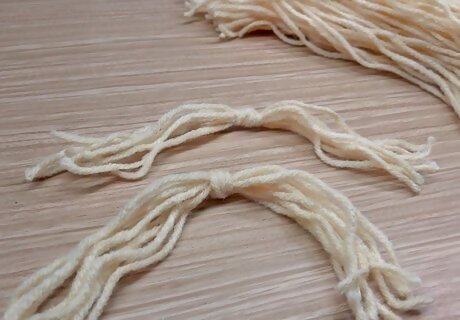
Tie 8 to 10 pieces of yarn together in the middle. Gather 8 to 10 pieces of the cut yarn together. Make sure that the ends match up, then tie the bundle into a knot in the middle. Repeat this step for all of the pieces of yarn that you cut. You'll end up with lots of little bundles. For a thinner tail, wrap the yarn 6 times. For a thicker tail, wrap the yarn 13 to 16 times.
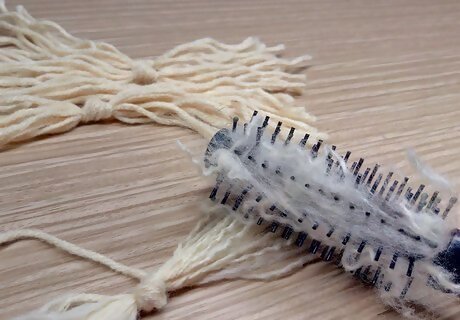
Brush the yarn bundle out, except for two strands. Separate two strands from the bundle, one on each side of the knot. Use a wide-toothed pet comb to brush the other strands out until they unravel and turn wavy. Repeat this step for all of the yarn bundles. Again, you will end up with lots of fluffy bits of yarn. The yarn bundle will become shorter. This is normal. Comb the bundle one more time with a fine-toothed comb to soften it further. You'll be using the two unbrushed strands to tie the bundles to the tail. For a more secure tail, brush these two strands out as well.
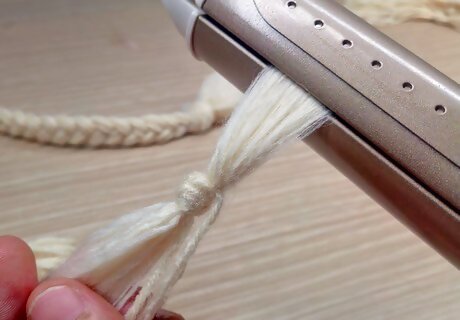
Straighten the brushed out yarn bundles. Set your hair straightener to the lowest setting possible. Use it to straighten the brushed out yarn until all of the ripples and waves disappear. It'll be easier if you straighten first one side of the knot, then the other. Do not straighten the strands that you used to tie the bundles together. Brush the bundles out with a fine-toothed pet comb afterwards to help them lay more smoothly.
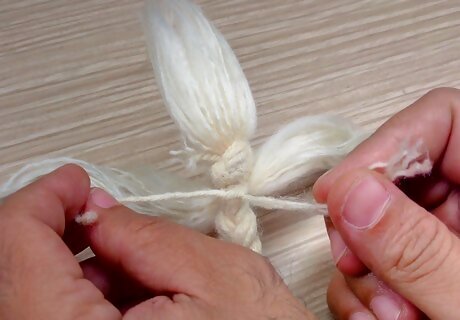
Tie your first bundle to the braid. Place a brushed-out yarn bundle against the bottom of the braid, right above the tie. Take the two strands of yarn you used to tie the bundle together, and wrap them around the braid. Tie the strands together into a tight, double-knot. If you brushed all of the strands out, sew the bundle to the braid by the knot instead. You can also use a drop of hot glue or fabric glue instead.
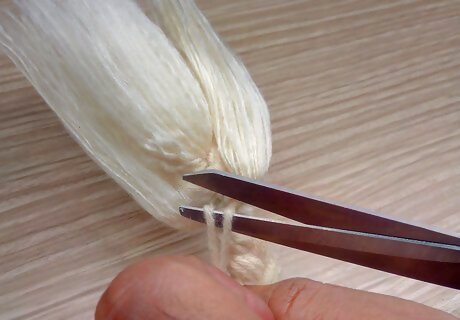
Trim the strands off. Alternatively, you can brush these strands out, and then straighten them, just like you did for the bundles. This will take more time, however, but it will give you a neater finish. If you sewed the bundles on, skip this step.
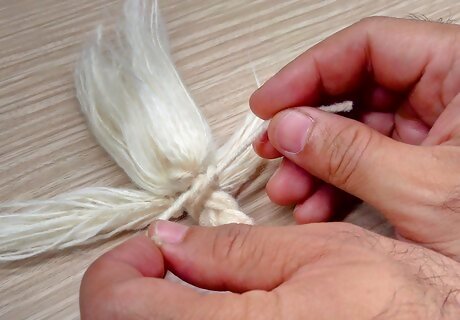
Tie the next bundle on the other side of the braid. Flip the braid over so that the back is facing you. Position the next bundle right above the knot where you tied off the first bundle. Wrap the tie strands around the braid, and tie them into a knot, just like before. Trim the strands out, or brush and straighten them.
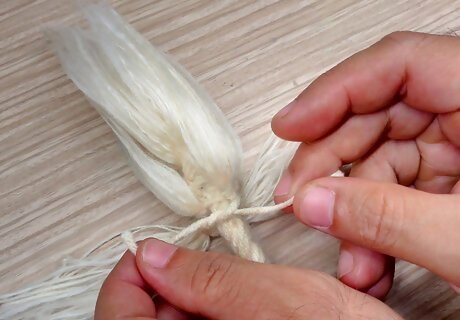
Continue tying the bundles to the tail. For a fuller tail, add the next third and fourth bundles on the left and right side of the tail. Repeat the process: front, back, left, and right, until you reach the top of the braid. Scrunch the bundles down as much as you can so that they are stacked on top of one another and you can't see the inner braid. For a thinner tail, tie the bundles ½ inch (1.27 centimeters) apart. If you are sewing the bundles on, work in neat rows, with the knots right next to each other.
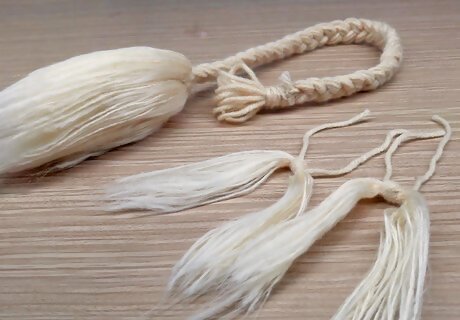
Make more bundles, if necessary. At one point, you may run out of bundles. If this is the case, make another batch using the same method as before. If you have any bundles left over, consider adding them into the tail to fill in any gaps.
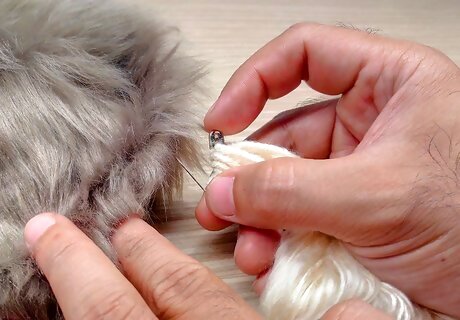
Attach the tail to your costume. There are a few ways you can do this. You can use the ties at the top of the braid to tie the tail to your belt. You can also use the ties to secure the tail to a key chain hook or ring, then hook that over your belt. A third option would be to sew or glue a flat-backed safety pin to the top of the tail and pin it to your costume.















Comments
0 comment